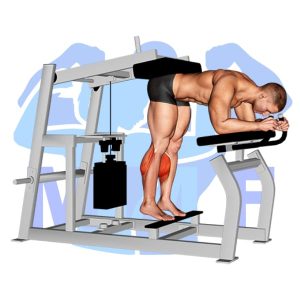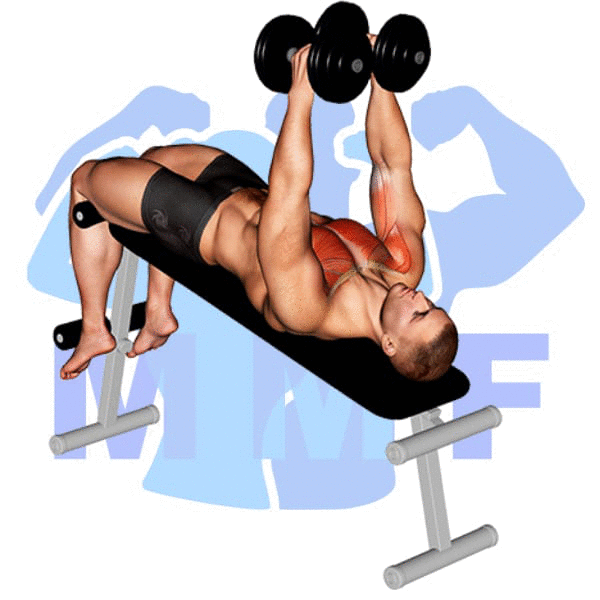If you have been struggling with calf strength or size, and are looking for ways to give your gastrocnemius muscle group a boost, look no further than the lever standing calf raise. Many gym-goers often find difficulty in targeting their calves and achieving the desired results, and it is a common problem faced by countless people. Don’t worry, you are not alone in this struggle. Genetics, poor form, and lack of variation in exercises can all contribute to underdeveloped calves. But fear not, in this post, we will delve into the benefits of incorporating the lever standing calf raise into your workout routine, a guaranteed solution to help you achieve the calf muscles you have always wanted.
Lever Standing Calf Raise (Machine) Summary
- Primary Muscles: Gastrocnemius
- Secondary Muscles: Soleus
- Equipment: Standing Calf Raise Machine
- Mechanics Type: Isolated
- Force: Push
- Utility: Basic

Lever Standing Calf Raise (Machine) Instructions
- Stand with your feet shoulder width apart, facing the lever.
- Position the lever at your ankles.
- Bend your knees slightly and lean forward at the hips.
- Lift your heels off the ground, coming up onto the balls of your feet.
- Hold this position for a few seconds.
- Lower your heels back to the ground.
- Repeat as desired.
Video Tutorial
Lever Standing Calf Raise (Machine) Muscles
Target (Agonist)
Synergists
- Soleus
Dynamic Stabilizers
- None
Stabilizers
Antagonist Stabilizers
- None

Benefits of Lever Standing Calf Raise (Machine)
The Lever Standing Calf Raise (Machine) is an effective exercise for strengthening the Gastrocnemius, a muscle in the back of the lower leg. This exercise helps to improve balance, agility, and coordination in the lower body as well as increase calf muscle strength and size. It can also help to improve ankle stability and overall lower body strength. Additionally, this exercise can help to improve running performance, reduce the risk of injury, and prevent shin splints. All of these benefits make the Lever Standing Calf Raise (Machine) a great addition to any strength training or fitness routine.
Tips for Performing Lever Standing Calf Raise (Machine)
Lever Standing Calf Raises are an effective way to strengthen the calf muscles, improve your balance and posture, and increase your flexibility. With the right form and technique, you can maximize the benefits of this exercise and get the most out of it. Here are a few tips to help you get the most out of your Lever Standing Calf Raises:
- Ensure proper form: It is important to keep your back and legs straight, with your feet flat on the floor and your toes pointed forward. Your knees should be slightly bent and you should be pushing through your heels when performing the exercise.
- Increase weight gradually: Start with a light weight and gradually increase the weight as your strength and muscles build up. This will help prevent injury and ensure that you are able to complete the exercise correctly.
- Maintain proper balance: When performing the Lever Standing Calf Raise, it is important to keep your balance and avoid leaning forward or backward. Keeping your weight centered over your feet will help you maintain proper form and ensure that you are able to get the most out of the exercise.
Benefits and Tips Video
Frequent Mistakes To Avoid
When it comes to performing the Lever Standing Calf Raise, it is important to keep in mind that there are some common mistakes that you should avoid. Poor form can lead to a variety of problems, from injury to ineffective results. To ensure that you are getting the most out of your exercise, it is important to be aware of these mistakes and make sure to avoid them.
- Not engaging the core muscles: It is important to engage your core muscles while performing this exercise to ensure proper form and stability. Neglecting to do so can result in an increased risk of injury.
- Not maintaining a neutral spine: A neutral spine should be maintained throughout the exercise to maximize the benefits and reduce the risk of injury. Allowing your back to arch or hunch can cause strain on the lower back.
- Not using full range of motion: It is important to lower the weight all the way down so that your calves are stretched to their full range of motion. This ensures that all of the muscle fibers are being worked, rather than just the top range of motion.
Find More Machine Exercises Here
Variations and Complementary Exercises
Below are a list of variations, complementary, and alternative exercises that work similar muscles as the Lever Standing Calf Raise (Machine). These exercises are great for those who do not have access to the machine or those who want to mix up their routine. By performing the exercises listed below, you can build strength in your calves and ankles while also working other muscles in your lower body.
Sled Calf Press

Sled Calf Press is a great alternative or complementary exercise to Lever Standing Calf Raise (Machine). This exercise works the same muscles as the Lever Standing Calf Raise (Machine), but in a different way. The Sled Calf Press requires you to load a weight plate onto a sled and then press it forward while keeping your legs straight. This forces you to use your calf muscles to push the weight forward, while still requiring balance and stability. It also works the quads and glutes. This exercise is great for building strength and endurance in the calf muscles, and can help improve performance in sports that require explosive power.
Smith Machine Calf Raise

The Smith Machine Calf Raise is a great complementary or alternative exercise to the Lever Standing Calf Raise (Machine). This exercise focuses on developing the calf muscles in a seated position. To perform this exercise, you need to stand on a raised platform with your toes on the edge and your heels hanging off. You then slowly lower your heels as far as possible, pause for a second, and then press through the balls of your feet to raise your heels back up. This exercise targets the soleus and gastrocnemius muscles and is great for athletes looking to increase their calf strength and stability.
Band Calf Raises

Band Calf Raises are an excellent complementary exercise for Lever Standing Calf Raises. This exercise helps to improve strength and stability in the lower legs, which can help to increase the efficacy of the machine exercise. The resistance band can be looped around the feet and held in the hands, and the calf muscles are then engaged as you raise your heels up and down against the resistance of the band. As well as providing an alternative to the machine, Band Calf Raises can be used as a warm up before doing Lever Standing Calf Raises, allowing the muscles to be properly prepared for the more strenuous exercise.
Check Out These Top Machine Exercises
Calf Raises With Bands

Calf Raises with Bands is an excellent complementary or alternative exercise to the Lever Standing Calf Raise (Machine). This exercise requires the use of a resistance band and works the calf muscles just like the machine. The major difference is that this exercise requires more balance and stability, as well as engaging other muscles to help support the movement. It also increases the range of motion, allowing for a deeper stretch of the calf muscles. This makes Calf Raises with Bands a great exercise for those looking for an alternative or complementary option to the Lever Standing Calf Raise (Machine).
Jump Rope

Jump rope is a great alternative or complementary exercise to the Lever Standing Calf Raise (Machine). Jump rope is an aerobic exercise that helps increase the speed and power of your lower body while improving coordination and agility. Jumping rope not only strengthens the calves, but also works your glutes, quads, hamstrings, and core. It is a great way to burn calories and improve cardiovascular endurance. Plus, it’s fun and easy to do anywhere. Jump rope is a great way to get your heart rate up and give your calves a break from the Lever Standing Calf Raise (Machine) while still getting an effective workout.
Lever Donkey Calf Raise (Machine)

The Lever Donkey Calf Raise (Machine) is a great complementary or alternative exercise for the Lever Standing Calf Raise (Machine). It works the same muscles and is performed in a similar fashion, but with a seated position. The Lever Donkey Calf Raise (Machine) allows users to perform more repetitions and isolate the soleus muscles more effectively than the Lever Standing Calf Raise (Machine). This machine also provides better stability and balance, making it safer to perform the exercise. It is a great way to target the calves and get the results you desire.
Find More Calves Exercises Here
Opposing Complementary Exercises
To maximize the benefits of the exercise Lever Standing Calf Raise (Machine), it is important to balance the workout by using opposing muscle groups. To do this, include the following exercises in your workout routine:
Dumbbell Single Leg Deadlift

The Dumbbell Single Leg Deadlift is a great exercise to complement the Lever Standing Calf Raise (Machine) because it works the opposing muscle group. This exercise focuses on your glutes, hamstrings, and core and helps to strengthen the muscles in your lower body. By doing this exercise you will improve your balance, stability and posture. Furthermore, this exercise will also help to improve the range of motion in your ankles and hips. Therefore, when coupled with the Lever Standing Calf Raise (Machine), which works your calf muscles, you are providing your lower body with a full range of motion and muscular strength.
Dumbbell Straight Leg Deadlift

The Dumbbell Straight Leg Deadlift is a great complement to the Lever Standing Calf Raise (Machine) exercise, as it works the opposing muscle group. This exercise targets the hamstrings and glutes, while the calf raise works the calves. By doing both exercises together, you can develop a balanced lower body and improve your overall strength and endurance. The deadlift also encourages good posture, as it involves a hinging action at the hip that is similar to sitting in a chair. This helps build core strength as well as strength in the lower back, which can be beneficial for both everyday activities and athletic performance.
Smith Machine Deadlift

The Smith Machine Deadlift is an effective exercise for strengthening the glutes, hamstrings, and lower back. It is a great complement to the Lever Standing Calf Raise (Machine), which primarily works the calves and lower legs. By engaging opposing muscle groups in these two exercises, you can work to build strength and stability throughout your entire lower body. The Smith Machine Deadlift allows you to safely lift heavier weights than with the Lever Standing Calf Raise (Machine), while still providing plenty of resistance to challenge the muscles. Together, these exercises provide an effective way to tone and strengthen your lower body.
Get Stronger Calves with These Lever Tips
Strong calves are a must for any athlete looking to maximize their performance. If you’re looking to build up your calf muscles, a lever standing calf raise can be a great exercise. However, it’s important to make sure you’re doing the exercise correctly to avoid injury. Here are some tips to keep in mind as you perform a lever standing calf raise: make sure your feet are shoulder-width apart and that the balls of your feet are on the edge of the lever platform. Keep your back straight and engage your core muscles throughout the exercise. Slowly raise your heels off the ground, then lower them back down to complete one repetition. Remember to breathe throughout the exercise, and increase the weight gradually as you build strength.
References: Wikipedia | ExRx.net | PubMed.gov | Comprehensive List of Calves Machine Exercises




